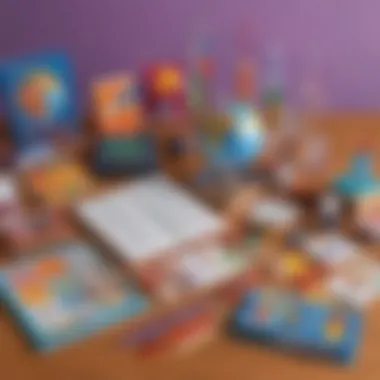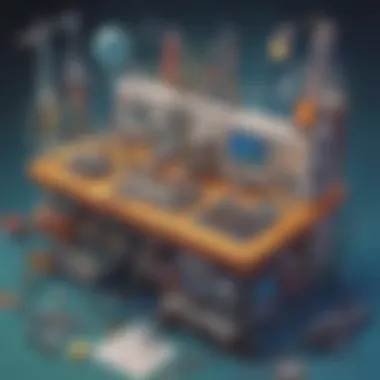Curating Exceptional Science Gifts for Twelve-Year-Olds


Intro
When it comes to finding that perfect science gift for a twelve-year-old, it’s a bit like trying to catch lightning in a bottle. The interests of pre-teens exhibit a dazzling range of curiosity that can spark joy and learning simultaneously. This gift selection journey starts with understanding what truly piques their interest. It’s not just about giving them something flashy but nurturing their budding fascination with the world around them. By offering them a window into scientific adventures, you can help them explore concepts that stretch far beyond the classroom.
In this guide, let’s dive into the vibrant universe of science-related gifts. We will break down the categories of educational kits, innovative technological tools, environmental endeavors, and captivating literature. Each of these gifts serves not just as a present but as a stepping stone toward a greater understanding of the sciences, methods, and principles that govern nature.
Moreover, we will infuse this exploration with numerous insights, fun facts, and thought-provoking questions that can spur conversation and foster an enriching gifting experience. Buckle up as we unravel the joy of gifting knowledge!
Understanding the Importance of Science Gifts
Selecting the right science gifts for twelve-year-olds goes far beyond simply wrapping up a shiny box. This stage in a child's life is critical for developing their interests and knowledge, and the right gift can help shape their future. With numerous distractions today, a well-chosen science gift can direct their focus towards curiosity and discovery, fostering an appreciation for the wonders of the natural world. By choosing gifts that ignite enthusiasm for science, parents and caregivers can create lasting memories that go hand-in-hand with learning.
One of the foremost benefits of science gifts is that they nurture curiosity and prompt kids to ask questions. Science is not just about facts and figures; it’s about exploration. Young minds have an innate desire to understand how things work, and when given the right tools, they can delve deeper into their interests. Items like chemistry sets or hands-on experiments provide tangible experiences that make learning engaging and fun.
Additionally, choosing the right science gifts can pave the way towards an engaged learning environment. Whether it’s building robots or compiling a weather diary, these activities encourage children to think critically and solve problems. Encouraging this type of learning fosters a mindset that values inquiry and persistence, equipping them with skills that benefit them in school and beyond.
"The greatest gift you can give your child is the gift of curiosity. It will take them further than any toy ever could."
Moreover, selecting science-oriented gifts can positively influence how kids view education as a whole. Rather than associating learning exclusively with textbooks and exams, they begin to see it as a way to explore their environment and have fun while doing so. This shift in perspective is vital during the pre-teen years when children start forming their own identities and values.
In summary, understanding the importance of science gifts lies in their potential to spark curiosity, promote exploration, and create enriched learning moments. Each gift choice carries the power to influence a young person's attitude towards science and education, making thoughtfully curated gifts truly invaluable.
Key Considerations for Choosing Science Gifts
Selecting the right science gift for a twelve-year-old isn’t as simple as handing over the hottest toy featured in a commercial. It's about tapping into their curiosity and ensuring that the gift is not only captivating but also developmentally beneficial. With such a formative age, the right present can spark interests that last a lifetime. Here’s a look at essential aspects to ponder when narrowing down options for your young one's next birthday or special occasion.
Assessing Age Appropriateness
When picking a science gift, age appropriateness should be top of mind. Twelve-year-olds are in a unique stage of cognitive and emotional development where they begin to engage more deeply with complex concepts. A gift that seems fascinating but is tailored for younger children may quickly lose its charm.
For instance, a basic chemistry set might seem thrilling, but if it lacks the complexity or real-world application that a twelve-year-old craves, it may end up collecting dust. Conversely, a more advanced kit, like a robotics platform that requires coding skills, can open doors of exploration and learning. Mark that down: the gift’s difficulty align with the recipient's abilities can make all the difference between boredom and engaged curiosity.
Identifying Personal Interests
Each child is wonderfully unique. For some, the cosmos holds mysteries that beg to be uncovered, while others might find excitement in the human body or ecosystems. Identifying what piques their interest can guide your gift choice significantly.
Consider asking questions or casually chatting about what they enjoy. Do they talk about space news, have a favorite scientist, or spend hours with nature documentaries? You could also check what subjects they gleefully tackle in school, as this often reveals hidden interests. Moreover, gifts like star-gazing kits, geological rock kits, or entomology starter kits can align well with their passions, steering them towards an enriched learning experience.
Evaluating Educational Value
Not all gifts are created equal, especially when it comes to their educational impact. It’s essential to gauge how a gift will benefit their learning journey. A good science gift should not only entertain but also expose kids to new concepts and critical thinking skills.
Hands-on activities, like a chemistry kit allowing them to perform experiments, can evoke a sense of discovery and accomplishment. Similarly, books that unravel the lives of famous scientists or delve into exciting scientific principles can stimulate their imaginations and drive curiosity beyond just the physical gift itself. In essence, it’s not merely about what they receive; it’s about the lifelong lessons and inspiration those gifts can impart.
Remember, a science gift should be a passport to a world of inquiry that nurtures budding scientists and thinkers.
Taking time to assess age appropriateness, identify individual interests, and evaluate educational value will ensure that the science gifts you choose leave a lasting impact on a twelve-year-old's evolving mind. It’s a step towards enhancing their intellectual growth and nurturing their innate curiosity.


Categories of Science Gifts
Selecting appropriate science gifts for twelve-year-olds goes beyond the mere act of gift-giving; it involves tapping into the vibrant world of scientific discovery. The right gifts can ignite an interest in science that might blossom into lifelong hobbies or even careers. There are several categories to choose, each serving a unique purpose in cementing knowledge and encouraging curiosity.
Hands-on Science Kits
Hands-on science kits stand out for their ability to bring theory to life. When a kid can physically interact with elements—from chemical reactions in a chemistry set to building robots—there's an immediate sense of achievement and understanding.
Chemistry Sets
Chemistry sets open the door to a world of experimentation. Crafted to teach the basics of chemical reactions, these sets often include real equipment like test tubes and safety goggles. The key characteristic of chemistry sets is the variety of experiments they offer, allowing kids to turn their curious thoughts into tangible outcomes. For instance, the Thames & Kosmos Chemistry C1000 set lets kids create reactions that can produce colorful outcomes or even smoke. However, while exciting, parents should supervise closely due to safety concerns with specific chemicals involved.
Robotics Kits
Robotics kits are another fantastic option that combines creativity and logic. They empower kids to design and build their machines, fostering both engineering skills and imaginative thought. A set like the LEGO Boost Creative Toolbox allows them to create working robots from everyday LEGO pieces. The hands-on nature of these kits promotes problem-solving and encourages resilience when things don’t work on the first try. The downside can be the cost, as some advanced kits might stretch the family budget.
Microscope and Specimen Sets
Microscopes paired with specimen sets take scientific exploration to a new microscopic level. Children can examine various slides, like onion skins or insect wings, gaining insights into biology that are rarely accessible through traditional means. The AmScope Kids Beginner Microscope Kit is a perfect illustration, as it includes prepared slides and tools for budding scientists. These kits bolster observational skills and inspire a love for biology. The potential downside is that the complexity can overwhelm some users; hence, guidance might be necessary for the youngest explorers.
Technological Gadgets
Technological gadgets bring the joy of learning into the digital arena. They offer interactive experiences that meld education with technology in a fun, engaging manner.
Educational Tablets
Educational tablets designed for kids provide a wealth of resources. They often include learning apps that gamify teaching, covering subjects from math to science. The Amazon Fire Kids Edition is a notable example, boasting a range of educational features nicely packed in a child-friendly design. The ease of access and variety of content make these tablets a favorite among parents seeking a modern approach. However, screen time must be managed, as too much can lead to eye strain or distraction from hands-on learning.
Programmable Robots
Programmable robots help children learn coding basics while they play. The Sphero Mini is tiny and mobile and can be controlled via a smartphone, allowing for various guidance challenges. These robots teach logical thinking and programming in a playful environment. A potential concern is the initial learning curve, which may be a bit steep for some kids; yet, the payoff in skills gained can be substantial.
Interactive Science Apps
Interactive science apps are a marriage of education and entertainment. They capture attention with fun visuals while teaching concepts. Apps like NASA's Eyes on the Solar System allow kids to explore planetary orbits in real time. The immersive experience can make complex topics like astronomy approachable and exciting. On the flip side, the reliance on screens can detract from physical activities, so it’s essential to maintain a balance.
Environmental and Nature Gifts
This category inspires appreciation and respect for nature. Gifts within this realm encourage outdoor activity and a connection with the environment.
Nature Observation Kits
Nature observation kits, like the National Geographic Kids Nature Explorer Kit, spark an interest in the natural world. Filled with tools to observe insects, plants, and wildlife, these kits encourage young scientists to step outside and engage with their surroundings. Such experiences foster curiosity and can lead to valuable conversations about ecosystems and conservation. The downside is that some kids might lose interest if they don’t see immediate results.
Gardening Kits for Kids
Gardening kits designed for kids create hands-on learning experiences related to biology and nature. The Back to the Roots Organic Herb Garden kit, for example, allows children to grow plants from seed to harvest, providing a rewarding experience. This interaction teaches them about sustainability and the food cycle. However, commitments are involved, and monitoring is needed to ensure plants thrive.


Wildlife Biological Project Kits
Wildlife biological project kits introduce children to ecosystems and wildlife biology. Kits such as 4M Botany Plant Growing Kit encourage observation and understanding of how living things interact. They often include everything needed—from seeds to guidance—making them user-friendly. The primary concern might be the maintenance of resources, which requires a bit of parental involvement.
Books and Literature
Books are timeless gifts that feed the mind and imagination. Within this category, there are endless options to stimulate interests and knowledge.
Popular Science Books
Popular science books bridge complex subjects in an easily digestible format. Titles like "The Magic of Reality" by Richard Dawkins explain science through intriguing narratives, drawing young readers into the wonders of the universe. They tend to foster a habit of reading while delivering knowledge. Still, children’s attention spans differ, so it’s crucial to match books with their interests to avoid books gathering dust.
Science Fiction for Young Readers
Science fiction can introduce young minds to imaginative possibilities while embedding STEM concepts. Books like "A Wrinkle in Time" by Madeleine L’Engle encourage children to think outside the box. The storytelling approach makes it easier to digest scientific ideas within entertaining plots. That said, some kids might prefer tales grounded in reality, posing a challenge for finding the right fit.
Biographies of Great Scientists
Biographies of great scientists introduce kids to influential figures who have shaped our world. Books such as "Who Was Albert Einstein?" engage children with stories of real-life heroes in science, illustrating how passion can lead to significant discoveries. They can serve as inspiration; however, some content may be too advanced for younger readers without proper guidance from an adult, necessitating a careful selection process.
By exploring these categories further, parents and caregivers can navigate the wide array of options available, ensuring the gifts chosen not only entertain but also enrich knowledge and espouse an interest in the sciences.
Future-Focused Science Gifts
When it comes to choosing gifts that nurture the imaginative capacities of twelve-year-olds, future-focused science gifts hold a prime spot. These gifts aren’t just about keeping up with trends; they are about preparing kids for the fast-evolving world of technology and innovation ahead. In an age where STEM (Science, Technology, Engineering, and Mathematics) is becoming crucial, it’s vital to opt for gifts that fuel growth and exploration in these areas.
Think of future-focused gifts as instruments that encourage children to not just consume technology but also learn how to create and innovate with it. By fostering their problem-solving abilities and creative skills, these gifts help them think critically and approach challenges with a do-it-yourself mentality. They instill a sense of confidence that they'll need as they carve out their own niche in an increasingly tech-driven world.
STEM-focused Options
- Engineering Kits
Engineering kits are an exceptional choice for fostering cognitive development. They come with a variety of components that kids can manipulate, enabling them to grasp fundamental engineering principles while having loads of fun. What makes these kits particularly appealing is their hands-on nature. Kids aren’t just reading about engineering; they’re doing it! They may build bridges, gears, or even simple machines, learning physics principles in the process. However, one potential downside is that some kits may require adult supervision, or the complexity might overwhelm some children. But for those who thrive on challenge, they become an enriching source of knowledge and practical experience. - Math Puzzles
Math puzzles are not merely games; they engage the young mind in a dynamic way. They can be both enjoyable and educational, making mathematics seem less like a chore and more like an adventure. A key feature here is diversity; they can vary from logic puzzles to riddles that require math skills to decode them. A big bonus is that these kinds of puzzles sharpen analytical thinking. But it’s worth mentioning that not every kid may enjoy puzzles, especially if they struggle with math concepts. Yet, for those who develop a knack for it, math puzzles can turn into a favorite pastime, unveiling layers of enjoyment in the subject. - Computer Coding Kits
With computers playing an integral role in daily life, computer coding kits represent a necessary foe for modern kids. These kits teach fundamental coding concepts in a playful manner. Many have interactive features and challenges that invite kids to create games or simple applications. What’s particularly beneficial about coding kits is they introduce children to logical thinking and problem-solving in an age-appropriate manner. On the flip side, if programming seems too challenging, it may dissuade a young learner instead of igniting interest. Nonetheless, for those who embrace it, such kits can provide a powerful launchpad into the realm of technology and possibilities ahead.
Gifts that Inspire Innovation
- Invention Kits
Invention kits present an open canvas for creativity. They encourage inventiveness by giving kids tools and components to conceptualize and build their own creations. It's like unlocking a treasure chest of imagination! The centerpiece here is the freedom to experiment, which often leads to unexpected results. While this can be thrilling, the vastness of possibilities could also leave some kids feeling a bit lost. But for those willing to dive in, the satisfaction of bringing their ideas to life can be immensely empowering. - Creative Building Sets
These sets tap into the innate desire children have to construct and innovate. They often feature a variety of pieces that can be assembled in countless ways. This kind of unstructured play is vital; it teaches spatial reasoning and logical thought processes through play. However, while these sets can be incredibly versatile, a child might become frustrated if they’re not able to realize their vision immediately. The key is guidance and encouragement to keep their spirits high as they experiment with different configurations. - 3D Printing Pens
The introduction of 3D printing pens is a game-changer in creative expression. It’s like giving kids the chance to draw not just on paper but in three dimensions. The main draw is the ability to visualize and tangibly create their ideas, fostering a sense of ownership and accomplishment. On the downside, mastering a 3D printing pen requires some practice, and results may vary based on skill level. But the potential for artistic freedom and innovation outweighs the initial learning curve. Kids may find themselves engrossed in crafting unique items, potentially important in igniting their passion for design.
Consider these elements carefully as you select future-focused science gifts. They are not just gifts; they are building blocks for a thoughtful and innovative future.
Gift Wrapping and Presentation
When it comes to gifting, the presentation can make all the difference. Sure, the contents of the package are vital, but how you wrap it can create an aura of excitement and anticipation. Gift wrappng is not just about aesthetics; it plays a role in enhancing the overall gifting experience, especially for science gifts aimed at twelve-year-olds. Whether you’re a parent, relative, or friend, consider the steps you take from the moment you decide to buy that science kit to the final reveal.
A well-wrapped gift piques curiosity. The way you present a gift sets the stage for what’s inside. In this instance, we’re talking about tools and toys designed to spark a kid's scientific interest. A unique wrapping theme—like a view of a galaxy for astronomy gifts or a nature-inspired design for environmental kits—can enhance the anticipation and framing of the entire experience.
Additionally, gifting isn’t just about giving it's a chance to forge a deeper connection. When the presentation is thoughtful, it shows the recipient you’ve put time into it. This thoughtfulness can help foster a child’s appreciation for the gift itself and even encourage them to dig deeper into the subject matter.
"Details matter. It’s the little things that can take a present from ordinary to extraordinary."


Creating a Thematic Presentation
A thematic presentation through gift wrapping allows you to tailor the excitement to the specific science area that interests the child. When you select the right theme, it can underscore the message behind the gift. Here are a few ideas:
- Space Explorer Kit: Use dark wrapping paper with star stickers scattered around. You might even attach a small model rocket to the bow for added flair.
- Botanical Gardening Set: Look for flower-printed paper, perhaps even adding pressed flowers as decoration to illustrate the connection with nature.
- Robotics Kit: Use metallic or circuit-patterned wrapping paper. Add small gears or LED lights to make it even more captivating.
These themed touches not only amplify the aesthetics but can also encourage discussions about the gift and its educational value. Your wrapper doesn't have to be fancy to be effective; sometimes, simplicity combined with creativity draws in the young recipients even more.
Personalizing the Gift Experience
To wrap it all up (literally), personalizing the gift experience can turn an already exciting moment into something memorable. Including a handwritten note with a message that resonates with the child’s interests can go a long way. Here are some ideas:
- Custom Tags: Instead of just a generic tag, use colored paper to create tags that highlight fun facts related to the gift's subject, such as "Did you know that honeybees communicate by dancing?" If the gift is a science kit, perhaps mention an experiment they can look forward to.
- Interactive Unwrapping: Consider adding small challenges within the wrapping. For example, put a riddle or puzzle in the wrapping that, when solved, reveals clues about the gift. It adds an element of surprise and excitement, making the unwrapping process engaging.
- Memory Lane: Reminisce about shared experiences related to science. If you have done experiments or science-related outings together, mention those in the note. It can foster a sense of nostalgia and connectedness, making the day even more special.
Taking the time to tailor the presentation and personalize the experience can make the profound impact that is sought after in science gifting. The goal is not just to give a gift but to create moments that resonate and ignite curiosity.
Gift-giving Etiquette and Considerations
Selecting the perfect science gift for a twelve-year-old is more than just picking something off a shelf; it's about navigating the intricate web of gift-giving etiquette. Understanding the nuances involved can significantly enhance not only the gifting experience but also the impact of the gift itself. This section emphasizes the importance of considering various aspects that can lead to a thoughtful and well-received present.
Understanding Parental Insights
Before finalizing any choice, it’s crucial to consider the parents’ perspective. Parents often have unique insights into their child’s needs and preferences, as they are keenly aware of their interests and any existing collections. A well-placed inquiry can go a long way.
- Communication is Key: A casual chat with the child’s parents can unveil critical information. Asking them about current interests could guide your decision. Are they into coding? Do they have a fascination with rockets or space?
- Safety Considerations: Parents are also attuned to which gifts are safe and suitable for their children’s age. So, understanding the guidelines they might hold can prevent any awkward situations. It’s common sense to respect their boundaries.
- Gift Usage: Parents generally appreciate when gifts align with their educational values. If you’re knowledgeable about what’s educational yet fun, your choice will likely be received favorably. Having a meaningful conversation can enhance mutual respect between you and the parent, building a better relationship in the long run.
Balancing Educational Needs and Fun
Finding that sweet spot between education and enjoyment can feel like walking a tightrope. Science gifts should stimulate the mind, but they also need to be engaging enough for a twelve-year-old to enjoy using them.
- Choose Engaging Products: Look for kits that provide hands-on experience, like chemistry sets or robotics kits. They offer a fantastic balance, allowing a child to become actively involved while learning something valuable.
- Avoid Overly Complex Gifts: While complex sets may capture attention, they may frustrate and discourage a young learner. Opt for gifts that promote exploration without overwhelming them on the first try.
- Incorporate Creativity: Many young minds thrive on creativity. Consider gifts that offer a creative outlet, such as building sets or invention kits. A playful twist on learning can make concepts stick better in their minds.
Gift-giving should feel like a celebration of curiosity, where the educational meets the entertaining.
By combining insights from parents with a keen understanding of what keeps children engaged, you can make thoughtful decisions that provide impactful learning experiences. Every well-chosen science gift holds the potential to inspire a young mind, laying the groundwork for lifelong learning.
Finale: Impact of Science Gifts on Young Minds
When we consider the role of science gifts in the lives of twelve-year-olds, it becomes evident that these gifts hold more significance than mere entertainment. At this age, children are stepping into a world bursting with possibilities, and the right science gifts can foster their growth in remarkable ways.
First and foremost, science gifts have the potential to spark curiosity. Many young minds are naturally inquisitive, and these gifts can provide them a platform to explore their interests in chemistry, biology, physics, and engineering. For instance, imagine a boy who opens a robotics kit on his birthday. The immediate joy may quickly transform into an obsession with how things work, which could lead him to a career in engineering — it all starts with that one thoughtful gift.
Moreover, such gifts promote deeper understanding of concepts by integrating learning with play. They can engage children in hands-on activities that are both fun and educational. Rather than staring at a screen passively, these kids can build, dissect, and create — all while developing critical thinking skills. Building a model volcano or programming a simple robot encourages problem-solving and analytical thinking, which are crucial in today’s complex world.
In addition to enhancing intellectual capabilities, science gifts contribute to social skills and teamwork. Many science kits are designed for group activities, encouraging children to collaborate with their peers or family members. This aspect of learning not only fosters friendships but also teaches them about the value of diverse perspectives in tackling challenges. Consider a group of friends working together to sift through a geology kit; they are not just learning about rocks but also practicing how to communicate their ideas effectively.
Reflecting on personal interests is crucial too. When gifts align with what a child is already excited about, the impact is heightened. Whether it’s a book about dinosaurs or an environmental project kit, these gifts affirm their passions and make learning feel relevant and personalized.
"The best gift you can give is the gift of discovery. It opens doors to a child's imagination, forging paths that lead to knowledge beyond their years."
Lastly, it’s important to remember that gifts should balance fun with educational value. The path of discovery might include playful aspects, but the foundation is built on understanding and engagement with real-world problems. By opting for educational gifts, you are creating opportunities for children to understand the world better, peer into its wonders, and ultimately, contribute positively to society.
As we navigate this journey of selecting science gifts for twelve-year-olds, we must approach it with thoughtfulness. Each gift carries the potential to inspire, nurture curiosity, and lay the groundwork for lifelong learning. The impact of these gifts often reaches far beyond the present moment, influencing not just their childhood, but also the course of their future.







